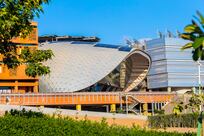A new solar equipment factory could come to the Arabian Gulf not to meet demand for clean energy, but to drive oil production.
Glasspoint, a California company testing a technology to coax oil from the ground using the sun's heat, is considering building a factory in the region should it receive enough local demand. It said yesterday that it had commissioned a 7-megawatt pilot facility for Petroleum Development Oman (PDO), making Oman the second country where solar power has been used to increase oil production from ageing fields.
"If PDO placed a full field order, that would be best with a local factory," said Rod MacGregor, the chief executive of Glasspoint. If the demand were sufficient, Glasspoint would finance the construction of a factory to manufacture equipment such as the curved aluminium mirrors that concentrate the sun's heat, which it now sources from China, and sell the product to regional oil producers, said Mr MacGregor.
Cutting transportation costs and import duties would help to offset the increased cost of manufacturing in the Arabian Gulf instead of China.
Such a factory would help to create local jobs by freeing up gas for industrial projects as well as advance the development of local solar manufacturing, which has stalled because of the lack of sufficient local demand. Plans by Masdar, Abu Dhabi's clean energy company, to start building a photovoltaic panel factory in Taweelah by 2009 have been shelved because of the absence of regional demand.
Another problem specific to photovoltaics is that massive factories built in China over the past couple years with the help of government subsidies have made other locations less competitive.
The pilot site in Oman relies on the same mirrors used in concentrated solar power plants, such as Abu Dhabi's Shams 1. A 6-metre-tall glass greenhouse, the same as those used to grow tomatoes in Holland, holds a row of massive aluminium mirrors that heat water, which then turns to steam. That steam then feeds into an existing steam-injection network in Oman's Amal field. PDO already burns natural gas there to produce the steam needed to extract heavy oil.
"Preliminary results from this project demonstrate that solar steam generated with GlassPoint's enclosed trough architecture is equally effective as natural gas for thermal EOR [enhanced oil recovery]," said Syham Bentouati, PDO's head of new technology implementation. "This unit serves as a performance and operational baseline for future solar steam generation projects in Oman, providing us with valuable information for planning potential future large-scale solar steam projects."
Royal Dutch Shell and Total, also shareholders in PDO, are direct and indirect investors in Glasspoint, which is eyeing opportunities in Kuwait, Bahrain, Libya and western China, and places where the cost of natural gas is higher than US$5, the break-even point for the solar technology to become competitive. Three to seven barrels of steam are required to extract one barrel of oil in Oman; in California, up to 20 barrels of steam can be needed.
Oman has been looking at options for EOR through solar for a decade.
Construction for the Omani pilot was completed in December. A design using a ready-made agricultural greenhouse, which keeps dust off the mirrors, helped the project stay on time, said Mr MacGregor.
"I don't think you'll see that in any of the other solar projects," said Mr MacGregor. "The greenhouse industry has been around for 100 years. If you're a farmer, you have a growing season, so if the greenhouse arrives late, the farmer misses his growing season."




